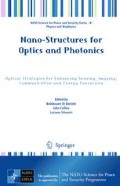Abstract
The development of innovative materials for sensitive and selective gas sensing is a very relevant field for the current nanotechnology research. A strong effort is dedicated to the fabrication of low-cost and efficient nanoscale devices capable of a fast detection. Resistive electrical devices are the most adopted solutions for in-situ and real-time detection, but their main drawbacks are the low selectivity, response drift, electromagnetic noise dependence and need of contact measurements. Optical gas sensors allow to overcome such limits, and could moreover exhibit thermal and mechanical stability, operate at room temperature, and be integrated on-chip. Within this framework, plasmon-based optical devices are knowing an increasing development and diffusion. Herein plasmonic sensors for aromatic hydrocarbon detection are presented. These systems are based on aryl-bridged polysilsesquioxanes (aryl-PSQs), obtained either \(\textcircled{1}\) coupling such hybrid films with Au nanoparticles (NPs), aiming to the excitation of localized surface plasmon resonances (LSPRs), or \(\textcircled{2}\) depositing them onto metallic waveguiding layers, to form gratings supporting the propagation of surface plasmon polaritons (SPPs). Aryl-PSQs are sol-gel materials characterized by a native controlled porosity and other functionalities (Loy and Shea, Chem Rev 95:1431–1442, 1995; Dabrowski et al., Appl Surf Sci 253:5747–5751, 2007; Brigo et al., Nanotechnology 23:325302, 2012). Temperature programmed desorption investigations of xylene on phenyl-bridged (ph-PSQ) and diphenyl-bridged (diph-PSQ) PSQ films indicate a specific π −π interaction between the organic component of the films and xylene molecules: the interaction energy is quantified in 38 ± 14 kJ/mol and 115 ± 13 kJ/mol, respectively (Brigo et al., J Mater Chem C 1:4252, 2013). For type \(\textcircled{1}\) sensors, a thin film of aryl-PSQ was deposited on a submonolayer of Au NPs coating a fused silica substrate. These sensors were tested monitoring the variation of the LSPRs under cycles of exposure to N2 and to 30 ppm xylene in N2.
Access this chapter
Tax calculation will be finalised at checkout
Purchases are for personal use only
Author information
Authors and Affiliations
Corresponding author
Editor information
Editors and Affiliations
Rights and permissions
Copyright information
© 2015 Springer Science+Business Media Dordrecht
About this paper
Cite this paper
Brigo, L. et al. (2015). Plasmonic Sensors for Aromatic Hydrocarbon Detection. In: Di Bartolo, B., Collins, J., Silvestri, L. (eds) Nano-Structures for Optics and Photonics. NATO Science for Peace and Security Series B: Physics and Biophysics. Springer, Dordrecht. https://doi.org/10.1007/978-94-017-9133-5_38
Download citation
DOI: https://doi.org/10.1007/978-94-017-9133-5_38
Published:
Publisher Name: Springer, Dordrecht
Print ISBN: 978-94-017-9132-8
Online ISBN: 978-94-017-9133-5
eBook Packages: Physics and AstronomyPhysics and Astronomy (R0)

